This topic gives you step-by-step instructions and best practices for making your Excel spreadsheets accessible to people with disabilities.
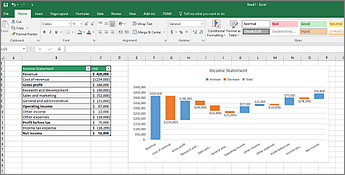
When your spreadsheets are accessible you unlock your content to everyone, and people with differing abilities can read and use Excel workbooks and charts. You learn, for example, how to add headers to tables so that people using screen readers are able to find the information they're looking for. You'll also learn how to use the Accessibility Checker to make sure your spreadsheets are inclusive.
Windows: Best practices for making Excel spreadsheets accessible
The following table includes key best practices for creating Excel spreadsheets that are accessible to people with disabilities.
| What to fix | How to find it | Why fix it | How to fix it |
|---|---|---|---|
| Include alternative text with all visuals. Visual content includes pictures, SmartArt graphics, shapes, groups, charts, embedded objects, ink, and videos. | To find all instances of missing alternative text in the spreadsheet, use the Accessibility Checker. | Alt text helps people who can't see the screen to understand what's important in images and other visuals. Avoid using text in images as the sole method of conveying important information. If you must use an image with text in it, repeat that text in the document. In alt text, briefly describe the image and mention the existence of the text and its intent. | Add alt text to visuals in Microsoft 365 |
| Add meaningful hyperlink text and ScreenTips. | To determine whether hyperlink text makes sense as standalone information and whether it gives readers accurate information about the destination target, visually scan the workbook. | People who use screen readers sometimes scan a list of links. Links should convey clear and accurate information about the destination. For example, instead of linking to the text Click here, include the full title of the destination page. Tip: You can also add ScreenTips that appear when your cursor hovers over a cell that includes a hyperlink. | |
| Use sufficient contrast for text and background colors. | To find insufficient color contrast, use the Accessibility Checker. You can also look for text in your spreadsheet that's hard to read or to distinguish from the background. | If your spreadsheet has a high level of contrast between text and background, more people can see and use the content. | |
| Give all sheet tabs unique names, and remove blank sheets. | To find out whether all sheets that contain content in a workbook have descriptive names and whether there are any blank sheets, use the Accessibility Checker. | Screen readers read sheet names, which provide information about what is found on the worksheet, making it easier to understand the contents of a workbook and to navigate through it. | |
| Use a simple table structure, and specify column header information. | To ensure that tables don't contain split cells, merged cells, or nested tables, use the Accessibility Checker. You can also visually scan your tables to check that they don't have any completely blank rows or columns. | Screen readers keep track of their location in a table by counting table cells. If a table is nested within another table or if a cell is merged or split, the screen reader loses count and can't provide helpful information about the table after that point. Blank cells in a table could also mislead someone using a screen reader into thinking that there is nothing more in the table. Screen readers also use header information to identify rows and columns. |
Add alt text to visuals in Microsoft 365
The following procedures describe how to add alt text to visuals in your Excel spreadsheets in Microsoft 365:
Tip: To write a good alt text, make sure to convey the content and the purpose of the image in a concise and unambiguous manner. The alt text shouldn't be longer than a short sentence or two—most of the time a few thoughtfully selected words will do. Do not repeat the surrounding textual content as alt text or use phrases referring to images, such as, "a graphic of" or "an image of."
Add alt text to images
Add alt text to images, such as pictures, screenshots, icons, videos, and 3D models, so that screen readers can read the text to describe the image to users who can't see the image.
-
Do one of the following:
-
Right-click an image, and select Edit Alt Text.
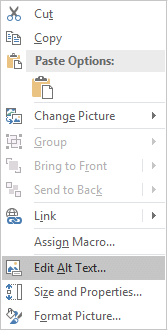
-
Select the image. Select Format > Alt Text.
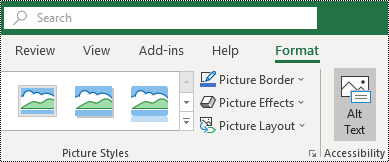
The Alt Text pane opens on the right side of the document body.
-
-
Type 1-2 sentences to describe the image and its context to someone who cannot see it.
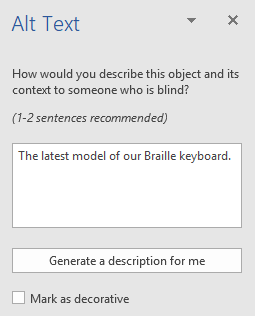
Tip: To spell check and correct a word you typed, just right-click the word and select from the suggested alternatives.
Add alt text to shapes or SmartArt graphics
-
Do one of the following:
-
Right-click a shape or SmartArt graphic, and select Edit Alt Text.
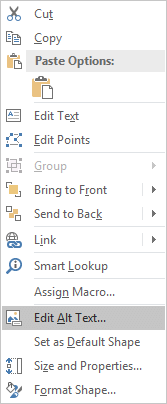
-
Select the shape or SmartArt graphic. Select Format > Alt Text.
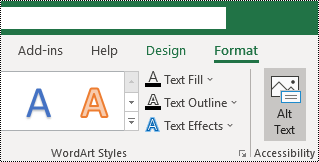
Note: To add alt text to the entire shape or SmartArt graphic, click the border of the shape or SmartArt graphic, and not an individual shape or piece.
The Alt Text pane opens on the right side of the document body.
-
-
Type 1-2 sentences to describe the shape or SmartArt graphic and its context to someone who cannot see it.
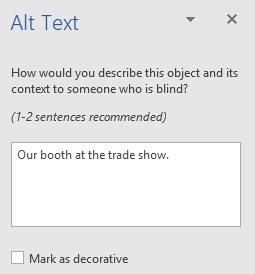
Tip: To spell check and correct a word you typed, just right-click the word and select from the suggested alternatives.
Add alt text to PivotCharts
-
Right-click a PivotChart.
-
Select Edit Alt Text.
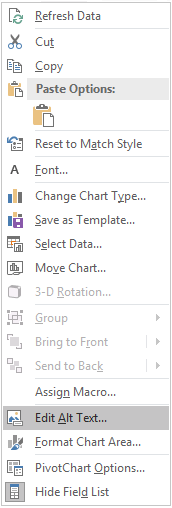
The Alt Text pane opens on the right side of the document body.
-
Type 1-2 sentences to describe the PivotChart and its context to someone who cannot see it.
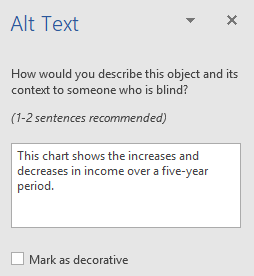
Tip: To spell check and correct a word you typed, just right-click the word and select from the suggested alternatives.
Make visuals decorative
If your visuals are purely decorative, such as stylistic borders that add visual interest but aren't informative, you can mark them as such without needing to write any alt text. People using screen readers will hear that these are decorative, so they know they are not missing any important information. When the document is exported to a PDF file, decorative elements will be marked within the PDF file with artifact tags, which are skipped over by screen readers.
-
Right-click a visual.
-
Select Edit Alt Text. The Alt Text pane opens on the right side of the document body.
-
Select the Mark as decorative text box. The text entry field becomes grayed out.

Toggle the Automatic Alt Text on and off
If you don't want to add automatically generated alt texts to inserted pictures, you can turn off the automatic alt text option. If you change your mind later, you can just as easily turn it back on.
-
Select File > Options > Ease of Access.
-
In the Automatic Alt Text section, select or unselect the Automatically generate alt text for me option, and then select OK.
Add alt text to visuals in Office 2019
The following procedures describe how to add alt text to visuals in your Excel spreadsheets in Office 2019:
Tip: To write a good alt text, make sure to convey the content and the purpose of the image in a concise and unambiguous manner. The alt text shouldn't be longer than a short sentence or two—most of the time a few thoughtfully selected words will do. Do not repeat the surrounding textual content as alt text or use phrases referring to images, such as, "a graphic of" or "an image of."
Add alt text to images
Add alt text to images, such as pictures, screenshots, icons, videos, and 3D models, so that screen readers can read the text to describe the image to users who can't see the image.
-
Do one of the following:
-
Right-click an image, and select Edit Alt Text.

-
Select the image. Select Format > Alt Text.

The Alt Text pane opens on the right side of the document body.
-
-
Type 1-2 sentences to describe the image and its context to someone who cannot see it.

Tip: Save time and add an alt text generated by the system to the image. In the Alt Text pane, select Generate a description for me. Then edit the automatic alt text to better suit the content.
Add alt text to shapes or SmartArt graphics
-
Do one of the following:
-
Right-click a shape or SmartArt graphic, and select Edit Alt Text.

-
Select the shape or SmartArt graphic. Select Format > Alt Text.

Note: To add alt text to the entire shape or SmartArt graphic, click the border of the shape or SmartArt graphic, and not an individual shape or piece.
The Alt Text pane opens on the right side of the document body.
-
-
Type 1-2 sentences to describe the shape or SmartArt graphic and its context to someone who cannot see it.

Tip: To spell check and correct a word you typed, just right-click the word and select from the suggested alternatives.
Add alt text to PivotCharts
-
Right-click a PivotChart.
-
Select Edit Alt Text.

The Alt Text pane opens on the right side of the document body.
-
Type 1-2 sentences to describe the PivotChart and its context to someone who cannot see it.

Tip: To spell check and correct a word you typed, just right-click the word and select from the suggested alternatives.
Make visuals decorative
If your visuals are purely decorative, such as stylistic borders that add visual interest but aren't informative, you can mark them as such without needing to write any alt text. People using screen readers will hear that these are decorative, so they know they are not missing any important information. When the document is exported to a PDF file, decorative elements are marked within the PDF file with artifact tags, which are skipped over by screen readers.
-
Right-click a visual.
-
Select Edit Alt Text. The Alt Text pane opens on the right side of the document body.
-
Select the Mark as decorative check box. The text entry field becomes grayed out.

Add alt text to visuals in Office 2016
The following procedures describe how to add alt text to visuals in your Excel spreadsheets in Office 2016:
Note: We recommend only putting text in the description field and leaving the title blank. This will provide the best experience with most major screen readers including Narrator. For audio and video content, in addition to alt text, include closed captioning for people who are deaf or have limited hearing.
Add alt text to images
Add alt text to images, such as pictures and screenshots, so that screen readers can read the text to describe the image to users who can't see the image.
-
Right-click an image.
-
Select Size & Properties.
-
Select Alt Text.
-
Type a description and a title.
Tip: Include the most important information in the first line, and be as concise as possible.
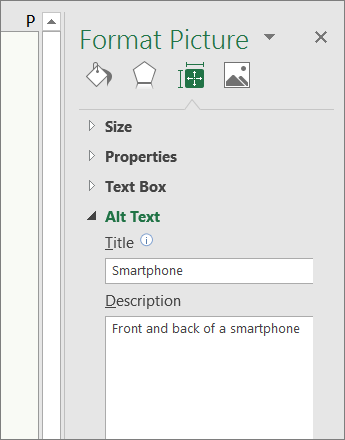
Add alt text to SmartArt graphics
-
Right-click a SmartArt graphic.
-
Select Size & Properties.
-
On the Shape Options tab, select Alt Text.
-
Type a description and a title.
Tip: Include the most important information in the first line, and be as concise as possible.
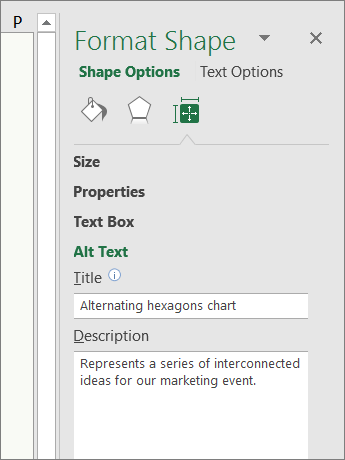
Add alt text to shapes
Add alt text to shapes, including shapes within a SmartArt graphic.
-
Right-click a shape.
-
Select Size & Properties.
-
On the Shape Options tab, select Alt Text.
-
Type a description and a title.
Tip: Include the most important information in the first line, and be as concise as possible.
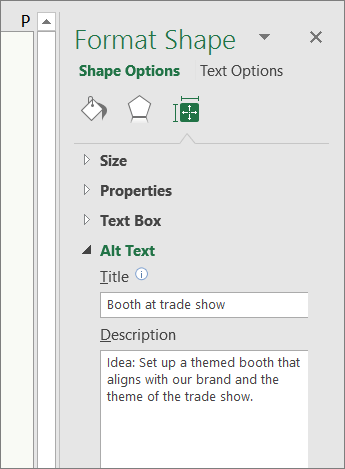
Add alt text to PivotCharts
-
Right-click a PivotChart.
-
Select Format Chart Area > Chart Options > Size & Properties.
-
Select Alt Text.
-
Type a description and a title.
Tip: Include the most important information in the first line, and be as concise as possible.
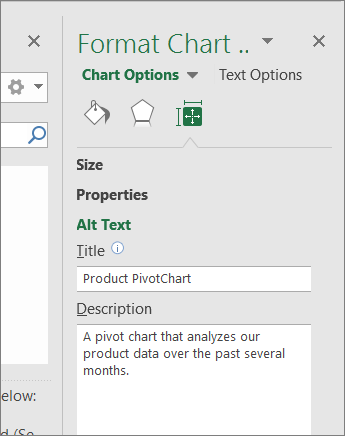
Make hyperlinks, tables, and sheet tabs accessible
The following procedures describe how to make the hyperlinks, tables, and sheet tabs in Excel spreadsheets accessible.
Add hyperlink text and ScreenTips
ScreenTips are small windows that display descriptive text when you rest the pointer on the hyperlink.
-
Select the cell where you want to add a hyperlink.
-
On the Insert tab, select Link.
-
In the Text to display box, the content of the cell you selected is displayed. This is the hyperlink text. To change it, type the new hyperlink text.
-
In the Address box, add the hyperlink URL.
-
Select the ScreenTip button and, in the ScreenTip text box, type the text of the ScreenTip.
-
Click OK > OK.
Tip: If the title on the hyperlink's destination page gives an accurate summary of what's on the page, use it for the hyperlink text. For example, this hyperlink text matches the title on the destination page: Templates and Themes for Office Online.
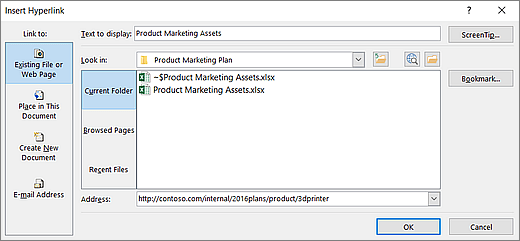
Use accessible text color
Here are some ideas to consider:
-
Ensure that the text displays well by using the Automatic setting for font colors. Select the cells that contain text, and then select Home > Font Color > Automatic.
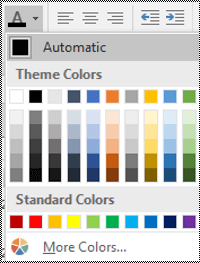
-
Use the Accessibility Checker to analyze the spreadsheet and find insufficient color contrast. It checks the text in the spreadsheet against the following things:
-
Page color
-
Cell backgrounds
-
Highlights
-
Text box fill
-
Paragraph shading
-
SmartArt fills
-
Headers, footers, and links
-
Use headers in an existing table
Specify a header row in a block of cells marked as a table.
-
Place the cursor anywhere in a table.
-
On the Table Tools Design tab, in the Table Style Options group, select the Header Row check box.
-
Type the column headings.
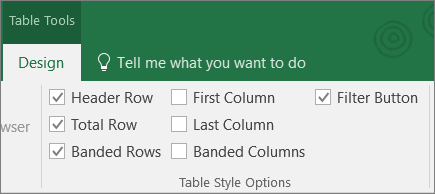
Add headers to a new table
Specify a header row in a new block of cells you are marking as a table.
-
Select the cells you want to include in the table.
-
On the Insert tab, select Table.
-
In the Create Table dialog, select the My table has headers check box.
-
Select OK.
Excel creates a header row with the default names Column1, Column2, and so on.
-
Type new, descriptive names for each column in the table.

Rename sheet tabs
-
Right-click a sheet tab, and select Rename.
-
Type a brief, unique name for the sheet, and press Enter.
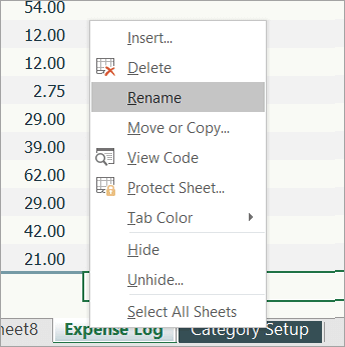
Delete sheet tabs
-
Right-click a sheet tab, and select Delete.
-
In the confirmation dialog, select Delete.
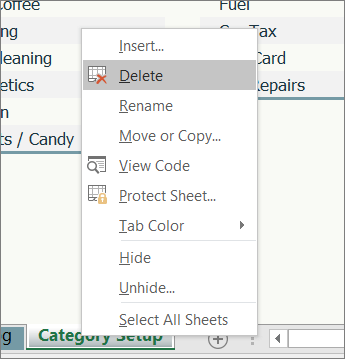
See also
Rules for the Accessibility Checker
Make your Word documents accessible to people with disabilities
Make your PowerPoint presentations accessible to people with disabilities
Make your Outlook email accessible to people with disabilities
Make your OneNote notebooks accessible to people with disabilities
Mac: Best practices for making Excel spreadsheets accessible
The following table includes key best practices for creating Excel spreadsheets that are accessible to people with disabilities.
| What to fix | How to find it | Why fix it | How to fix it |
|---|---|---|---|
| Include alternative text with all visuals. Visual content includes pictures, SmartArt graphics, shapes, groups, charts, embedded objects, ink, and videos. | To find all instances of missing alternative text in the spreadsheet, use the Accessibility Checker. | Alt text helps people who can't see the screen to understand what's important in images and other visuals. Avoid using text in images as the sole method of conveying important information. If you must use an image with text in it, repeat that text in the document. In alt text, briefly describe the image and mention the existence of the text and its intent. | Add alt text to visuals in Microsoft 365 |
| Add meaningful hyperlink text and ScreenTips. | To determine whether hyperlink text makes sense as standalone information and whether it gives readers accurate information about the destination target, visually scan the sheets in your workbook. | People who use screen readers sometimes scan a list of links. Links should convey clear and accurate information about the destination. For example, instead of linking to the text Click here, include the full title of the destination page. Tip: You can also add ScreenTips that appear when your cursor hovers over a cell that includes a hyperlink. | |
| Give all sheet tabs unique names, and remove blank sheets. | To find out whether all sheets that contain content in a workbook have descriptive names and whether there are any blank sheets, use the Accessibility Checker. | Screen readers read sheet names, which provide information about what is found on the worksheet, making it easier to understand the contents of a workbook and to navigate through it. | |
| Use a simple table structure, and specify column header information. | To ensure that tables don't contain split cells, merged cells, or nested tables, use the Accessibility Checker. You can also visually scan your tables to check that they don't have any completely blank rows or columns. | Screen readers keep track of their location in a table by counting table cells. If a table is nested within another table or if a cell is merged or split, the screen reader loses count and can't provide helpful information about the table after that point. Blank cells in a table could also mislead someone using a screen reader into thinking that there is nothing more in the table. Screen readers also use header information to identify rows and columns. |
Add alt text to visuals in Microsoft 365
The following procedures describe how to add alt text to visuals in your Excel spreadsheets in Microsoft 365:
Note: For audio and video content, in addition to alt text, include closed captioning for people who are deaf or have limited hearing.
Tip: To write a good alt text, make sure to convey the content and the purpose of the image in a concise and unambiguous manner. The alt text shouldn't be longer than a short sentence or two—most of the time a few thoughtfully selected words will do. Do not repeat the surrounding textual content as alt text or use phrases referring to images, such as, "a graphic of" or "an image of."
Add alt text to images
Add alt text to images, such as pictures and screenshots, so that screen readers can read the text to describe the image to users who can't see the image.
-
Do one of the following:
-
Right-click an image. Select Edit Alt Text….
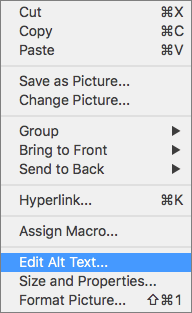
-
Select an image. Select Picture Format > Alt Text.
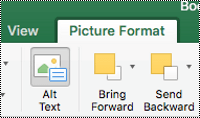
The Alt Text pane opens.
-
-
Type 1-2 sentences to describe the image and its context to someone who cannot see it.
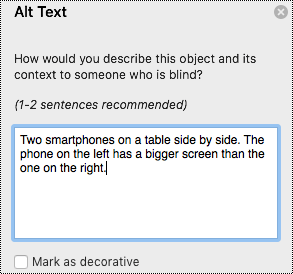
Tip: To spell-check the word you just typed, right-click the word and select an option from the list.
Add alt text to shapes
-
Do one of the following:
-
Right-click a shape. Select Edit Alt Text….
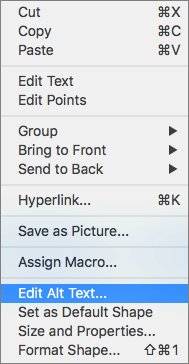
Tip: You have to right-click somewhere inside the frame that surrounds the entire shape, not inside one of its parts
-
Select a shape. Select Shape Format > Alt Text.
The Alt Text pane opens.

-
-
Type 1-2 sentences to describe the shape and its context to someone who cannot see it.

Tip: To spell-check the word you just typed, right-click the word and select an option from the list.
Add alt text to SmartArt graphics
-
Do one of the following:
-
Right-click a SmartArt graphic. Select Edit Alt Text….

Tip: You have to right-click somewhere inside the frame that surrounds the entire SmartArt graphic, not inside one of its parts
-
Select a SmartArt graphic. Select Format > Alt Text.

The Alt Text pane opens.
-
-
Type 1-2 sentences to describe the SmartArt graphic and its context to someone who cannot see it.

Tip: To spell-check the word you just typed, right-click the word and select an option from the list.
Add alt text to PivotTable
-
Right-click a PivotTable, and select PivotTable Options....
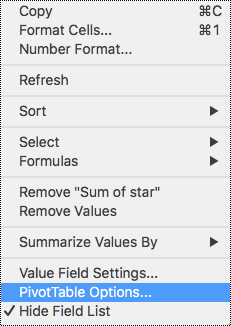
Tip: You have to right-click somewhere inside the frame that surrounds the entire chart, not inside one of its parts
-
In the PivotTable Options... dialog, select Alt Text.
-
In the Alt Text tab, type a title for the PivotTable in the Title text box.
-
In the Description text box, type 1-2 sentences to describe the table and its context to someone who cannot see it. Once you're done, select OK.
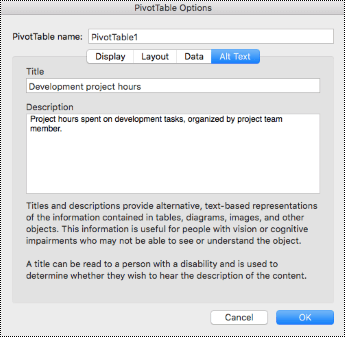
Tip: To spell-check the word you just typed, right-click the word and select an option from the list.
Mark visuals as decorative
If your visuals are purely decorative and add visual interest but aren't informative, you can mark them as such without needing to write any alt text. Examples of objects that should be marked as decorative are stylistic borders. People using screen readers will hear that these objects are decorative so they know they aren't missing any important information.
-
To open the Alt Text pane, do one of the following:
-
Right-click a visual. Select Edit Alt Text….
-
Select a visual. Select the Format tab for the visual > Alt Text.
The Alt Text pane opens.
-
-
Select the Mark as decorative check box. The text entry field becomes grayed out.

Tip: If you have several decorative items, you can edit them in a batch. Select them all, open the Alt Text pane, and click Decorative.
Add alt text to visuals in Office 2019
The following procedures describe how to add alt text to visuals in your Excel spreadsheets in Office 2019:
Note: For audio and video content, in addition to alt text, include closed captioning for people who are deaf or have limited hearing.
Tip: To write a good alt text, make sure to convey the content and the purpose of the image in a concise and unambiguous manner. The alt text shouldn't be longer than a short sentence or two—most of the time a few thoughtfully selected words will do. Do not repeat the surrounding textual content as alt text or use phrases referring to images, such as, "a graphic of" or "an image of."
Add alt text to images
Add alt text to images, such as pictures and screenshots, so that screen readers can read the text to describe the image to users who can't see the image.
-
Do one of the following:
-
Right-click an image. Select Edit Alt Text….

-
Select an image. Select Picture Format > Alt Text.

The Alt Text pane opens.
-
-
Type 1-2 sentences to describe the image and its context to someone who cannot see it.

Tip: To spell-check the word you just typed, right-click the word and select an option from the list.
Add alt text to shapes
-
Do one of the following:
-
Right-click a shape. Select Edit Alt Text….

Tip: You have to right-click somewhere inside the frame that surrounds the entire shape, not inside one of its parts
-
Select a shape. Select Shape Format > Alt Text.
The Alt Text pane opens.

-
-
Type 1-2 sentences to describe the shape and its context to someone who cannot see it.

Tip: To spell-check the word you just typed, right-click the word and select an option from the list.
Add alt text to SmartArt graphics
-
Do one of the following:
-
Right-click a SmartArt graphic. Select Edit Alt Text….

Tip: You have to right-click somewhere inside the frame that surrounds the entire SmartArt graphic, not inside one of its parts
-
Select a SmartArt graphic. Select Format > Alt Text.

The Alt Text pane opens.
-
-
Type 1-2 sentences to describe the SmartArt graphic and its context to someone who cannot see it.

Tip: To spell-check the word you just typed, right-click the word and select an option from the list.
Add alt text to PivotTable
-
Right-click a PivotTable, and select PivotTable Options....

Tip: You have to right-click somewhere inside the frame that surrounds the entire chart, not inside one of its parts.
-
In the PivotTable Options... dialog, select Alt Text.
-
In the Alt Text tab, type a title for the PivotTable in the Title text box.
-
In the Description text box, type 1-2 sentences to describe the table and its context to someone who cannot see it. Once you're done, select OK.

Tip: To spell-check the word you just typed, right-click the word and select an option from the list.
Mark visuals as decorative
If your visuals are purely decorative and add visual interest but aren't informative, you can mark them as such without needing to write any alt text. Examples of objects that should be marked as decorative are stylistic borders. People using screen readers will hear that these objects are decorative so they know they aren't missing any important information.
-
To open the Alt Text pane, do one of the following:
-
Right-click a visual. Select Edit Alt Text….
-
Select a visual. Select the Format tab for the visual > Alt Text.
The Alt Text pane opens.
-
-
Select the Mark as decorative check box. The text entry field becomes grayed out.

Tip: If you have several decorative items, you can edit them in a batch. Select them all, open the Alt Text pane, and click Mark as decorative.
Add alt text to visuals in Office 2016
The following procedures describe how to add alt text to visuals in your Excel spreadsheets in Office 2016:
Note: For audio and video content, in addition to alt text, include closed captioning for people who are deaf or have limited hearing.
Add alt text to images
Add alt text to images, such as pictures, and screenshots, so that screen readers can read the text to describe the image to users who can't see the image.
-
Right-click an image.
-
Select Format Picture > Size & Properties.
-
Select Alt Text.
-
Type a description and a title.
Tip: Include the most important information in the first line, and be as concise as possible.
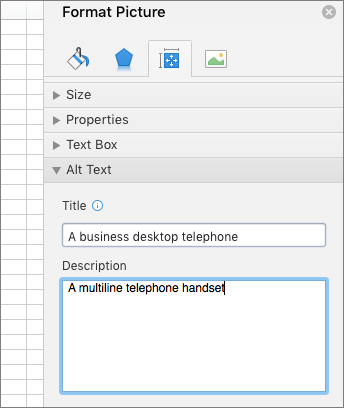
Add alt text to SmartArt graphics
-
Right-click a SmartArt graphic.
-
Select Format Shape > Shape Options > Size & Properties.
-
Select Alt Text.
-
Type a description and a title.
Tip: Include the most important information in the first line, and be as concise as possible.
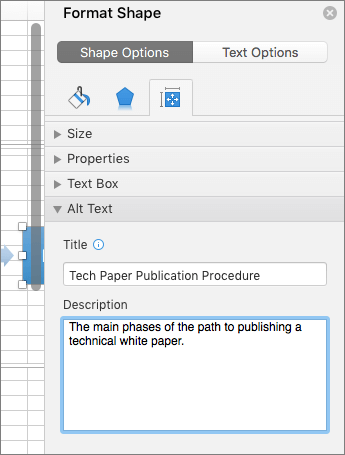
Add alt text to shapes
Add alt text to shapes, including shapes within a SmartArt graphic.
-
Right-click a shape.
-
Select Format Shape > Shape Options > Size & Properties.
-
Select Alt Text.
-
Type a description and a title.
Tip: Include the most important information in the first line, and be as concise as possible.
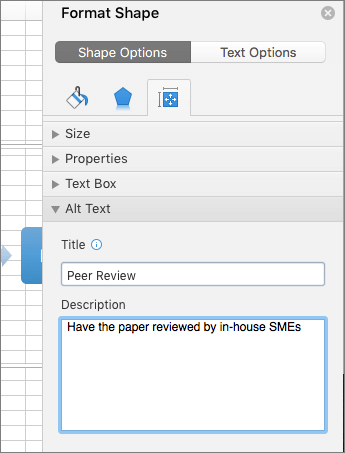
Add alt text to PivotCharts
-
Right-click a PivotChart.
-
Select Format Chart Area > Chart Options > Size & Properties.
-
Select Alt Text.
-
Type a description and a title.
Tip: Include the most important information in the first line, and be as concise as possible.
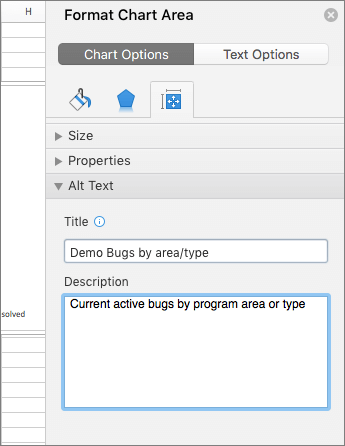
Make hyperlinks, tables, and sheet tabs accessible
The following procedures describe how to make the hyperlinks, tables, and sheet tabs in Excel spreadsheets accessible.
Add hyperlink text and ScreenTips
-
Right-click a cell.
-
Select Hyperlink.
-
In the Text to display box, type the hyperlink text.
-
In the Address box, type the destination URL.
-
Select the ScreenTip button and, in the ScreenTip text box, type a ScreenTip.
Tip: If the title on the hyperlink's destination page gives an accurate summary of what's on the page, use it for the hyperlink text. For example, this hyperlink text matches the title on the destination page: Templates and Themes for Office Online.

Use headers in an existing table
Specify a header row in a block of cells marked as a table.
-
Position the cursor anywhere in a table.
-
On the Table tab, select the Header Row check box.
-
Type column headings.
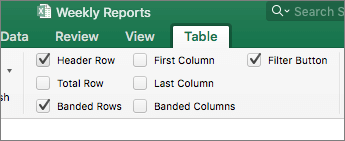
Add headers to a new table
Specify a header row in a new block of cells you are marking as a table.
-
Select the cells you want to include in the table.
-
On the Insert tab, select Table.
-
Select the My table has headers check box.
-
Select OK.
Excel creates a header row with the default names Column1, Column2, and so on. -
Type new, descriptive names for each column in the table.

Rename sheet tabs
-
Right-click a sheet tab, and select Rename.
-
Type a brief, unique name for the sheet.
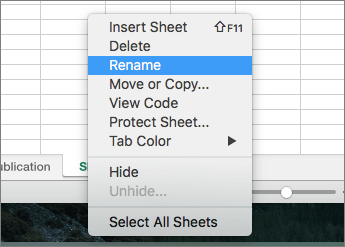
Delete a sheet tab
-
Right-click a sheet tab.
-
Select Delete.
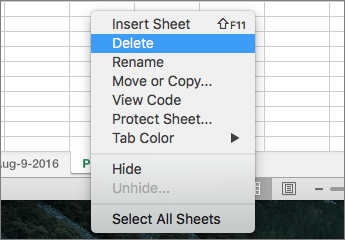
See also
Rules for the Accessibility Checker
Make your Word documents accessible to people with disabilities
Make your PowerPoint presentations accessible to people with disabilities
Make your Outlook email accessible to people with disabilities
Make your OneNote notebooks accessible to people with disabilities
iOS: Best practices for making Excel spreadsheets accessible
The following table includes key best practices for creating Excel spreadsheets that are accessible to people with disabilities.
| What to fix | Why fix it | How to fix it |
| Give all sheet tabs unique names. | Screen readers read sheet names, which provide information about what is found on the worksheet, making it easier to understand the contents of a workbook and to navigate through it. | |
| Use a simple table structure, and specify column header information. | Screen readers keep track of their location in a table by counting table cells. If a table is nested within another table or if a cell is merged or split, the screen reader loses count and can't provide helpful information about the table after that point. Blank cells in a table could also mislead someone using a screen reader into thinking that there is nothing more in the table. Screen readers also use header information to identify rows and columns. |
Make tables and sheet tabs accessible
The following procedures describe how to make the tables and sheet tabs in your Excel spreadsheets accessible.
Add headers to existing tables
Specify a header row in a block of cells marked as a table.
-
Select the cells or the row you want to convert to a header.
-
Tap the More icon in the bottom right corner of the screen.
-
Tap Cell Styles and select an option in the Titles and Headings group. The cells are converted to headers.

Rename sheet tabs
-
Tap the Sheet icon in the bottom left corner of the screen.
-
Tap a sheet tab and select Rename.
-
To replace the selected sheet name, type a brief, unique name for the sheet.

See also
Rules for the Accessibility Checker
Make your Word documents accessible to people with disabilities
Make your PowerPoint presentations accessible to people with disabilities
Make your Outlook email accessible to people with disabilities
Make your OneNote notebooks accessible to people with disabilities
Android: Best practices for making Excel spreadsheets accessible
The following table includes key best practices for creating Excel spreadsheets that are accessible to people with disabilities.
| What to fix | Why fix it | How to fix it |
| Include alternative text with all visuals and tables. Visual content includes pictures, SmartArt graphics, shapes, groups, charts, embedded objects, ink, and videos. | Alt text helps people who can't see the screen to understand what's important in images and other visuals. Avoid using text in images as the sole method of conveying important information. If you must use an image with text in it, repeat that text in the document. In alt text, briefly describe the image and mention the existence of the text and its intent. | |
| Give all sheet tabs unique names. | Screen readers read sheet names, which provide information about what is found on the worksheet, making it easier to understand the contents of a workbook and to navigate through it. | |
| Use a simple table structure, and specify column header information. | Screen readers keep track of their location in a table by counting table cells. If a table is nested within another table or if a cell is merged or split, the screen reader loses count and can't provide helpful information about the table after that point. Blank cells in a table could also mislead someone using a screen reader into thinking that there is nothing more in the table. Screen readers also use header information to identify rows and columns. |
Add alt text to visuals
The following procedures describe how to add alt text to visuals in your Excel spreadsheets.
Note: For audio and video content, in addition to alt text, include closed captioning for people who are deaf or have limited hearing.
Add alt text to images
Add alt text to images such as pictures and screenshots so that screen readers can read the text to describe the image to users who can't see the image.
-
Select an image.
-
To open the Picture tab, at the bottom of the screen, at the end of the toolbar, tap the up arrow.
-
Scroll down to the Alt Text command, and then tap it.
-
Type a description and a title. Your changes are automatically saved.
Tip: Include the most important information in the first line, and be as concise as possible.
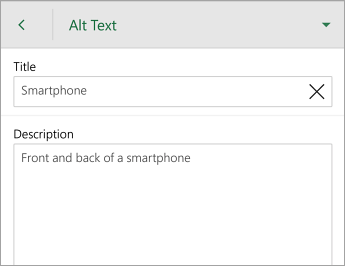
Add alt text to shapes
Add alt text to shapes including shapes within a SmartArt graphic.
-
Select a shape.
-
To open the Shape tab, at the bottom of the screen, at the end of the toolbar, tap the up arrow.
-
Scroll down to the Alt Text command, and then tap it.
-
Type a description and a title. Your changes are automatically saved.
Tip: Include the most important information in the first line, and be as concise as possible.
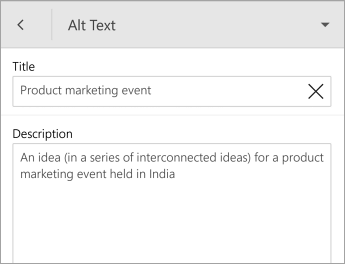
Add alt text to charts
-
Select a chart.
-
To open the Chart tab, at the bottom of the screen, at the end of the toolbar, tap the up arrow.
-
Scroll down to the Alt Text command, and then tap it.
-
Type a description and a title. Your changes are automatically saved.
Tip: Include the most important information in the first line, and be as concise as possible.

Make tables and sheet tabs accessible
The following procedures describe how to make the tables and sheet tabs in your Excel spreadsheets accessible.
Use headers in existing tables
Specify a header row in a block of cells marked as a table.
-
Position the cursor anywhere in a table.
-
To open the Table tab, at the bottom of the screen, at the end of the toolbar, tap the down arrow.
-
To select the Header Row option, tap it.
Tip: When the option is selected, it's gray.
-
In your table, type column headings.
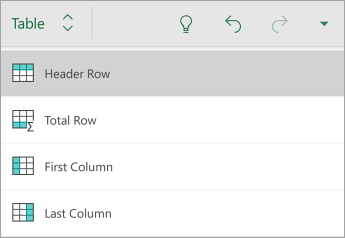
Add headers to new tables
Specify a header row in a new block of cells you are marking as a table.
-
Highlight the cells you want to include in the table.
-
To open the Home tab, at the bottom of the screen, at the end of the toolbar, tap the up arrow.
-
Tap Home > Insert.
-
Tap the Table command.
-
Select the Table has headers check box.
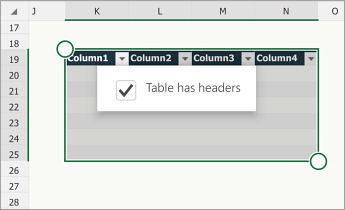
Rename sheet tabs
-
Tap and hold a sheet tab, and select Rename.
-
Type a brief, unique name for the sheet.

See also
Rules for the Accessibility Checker
Make your Word documents accessible to people with disabilities
Make your PowerPoint presentations accessible to people with disabilities
Make your Outlook email accessible to people with disabilities
Make your OneNote notebooks accessible to people with disabilities
Office Online: Best practices for making Excel Online spreadsheets accessible
The following table includes key best practices for creating Excel for the web spreadsheets that are accessible to people with disabilities.
| What to fix | How to find it | Why fix it | How to fix it |
|---|---|---|---|
| Include alternative text with all visuals and tables. | Use the Accessibility Checker to find instances of missing alternative text in the spreadsheet. | Alt text helps people who can't see the screen to understand what's important in tables. Avoid using text in tables as the sole method of conveying important information. In alt text, briefly describe the contents of the table and its intent. | |
| Add meaningful hyperlink text. | To determine whether hyperlink text makes sense as standalone information and whether it gives readers accurate information about the destination target, visually scan the workbook. | People who use screen readers sometimes scan a list of links. Links should convey clear and accurate information about the destination. For example, instead of linking to the text Click here, include the full title of the destination page. | |
| Give all sheet tabs unique names, and remove blank sheets. | Read the names of the sheet tabs in your workbook, and verify that each sheet has content. | Screen readers read sheet names, which provide information about what is found on the worksheet, making it easier to understand the contents of a workbook and to navigate through it. | |
| Use a simple table structure, and specify column header information. | Use the Accessibility Checker to ensure that tables don't contain split cells, merged cells, nested tables, or completely blank rows or columns. | Screen readers keep track of their location in a table by counting table cells. If a table is nested within another table or if a cell is merged or split, the screen reader loses count and can't provide helpful information about the table after that point. Blank rows and columns in a table could also mislead someone using a screen reader into thinking that there is nothing more in the table. Screen readers also use header information to identify rows and columns. |
Add alt text to images and charts
The following procedures describe how to add alt text to images and charts in your Excel for the web spreadsheets. To add alt text to tables, use a desktop version of Excel.
Note: We recommend only putting text in the description field and leaving the title blank. This will provide the best experience with most major screen readers including Narrator.
Add alt text to images
-
Right-click the image, and then select Alt Text to open the Alternative Text dialog box.
-
Revise the text in the Description text box.
-
Select OK.
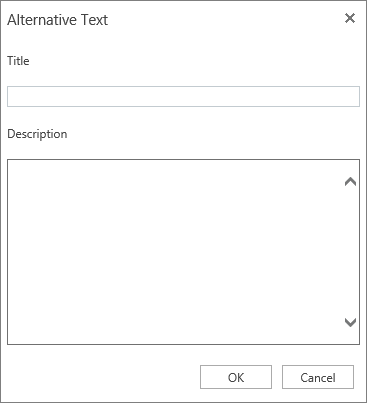
Add alt text to charts
-
Right-click the chart, and then select Alt Text to open the Alternative Text dialog box.
-
Add text in the Description text box.
-
Select OK.
Make hyperlinks, tables, and sheet tabs accessible
The following procedures describe how to make the hyperlinks, tables, and sheet tabs in Excel for the web spreadsheets accessible.
Add hyperlink text
-
Right-click a cell.
-
Select Hyperlink.
-
In Display Text, type the text that people will click on. Then, depending on the type of link you want to use, do one of the following:
-
In URL, type or paste the address.
-
In Place in this document, type the location of the cell you want to link to. For example, A6.
-
In Email address, type the email address in the format of someone@example.com.
-
-
Click OK.
Tip: If the title on the hyperlink's destination page gives an accurate summary of what's on the page, use it for the hyperlink text. For example, this hyperlink text matches the title on the destination page: Templates and Themes for Office Online.
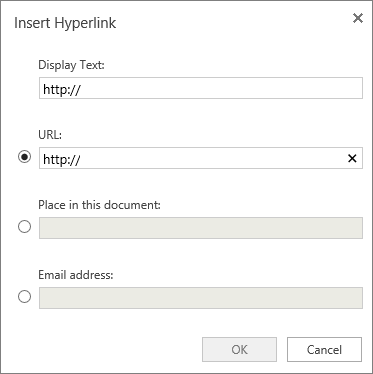
Use headers in a table
-
Select the cells you want to include in the table.
-
On the Insert tab, in the Tables group, select Table.
-
Select the My table has headers check box.
-
Select OK. Excel for the web creates a header row with the default names Column1, Column2, and so on.
-
Type new, descriptive names for each column in the table.
Note: Use these same steps to add a header to cells in an existing table.
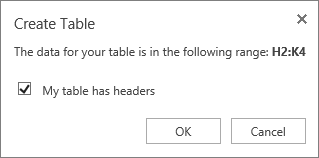
Give the workbook a meaningful name
-
Select File > Save As.
-
Select Save As, and then type a name for the file. Create a name that provides a hint about what kind of data the file contains. If possible, include the date as part of the name.
-
(Optional) Select the Replace existing file check box.
-
Select OK.
Note: If you want to rename a file, select Rename, type the name for the file, and select OK.
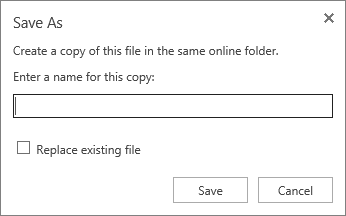
Rename sheet tabs
-
Right-click a sheet tab, and select Rename.
-
Type a brief, unique name for the tab that's descriptive of its contents.
-
Select OK.
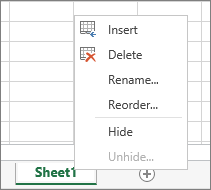
Delete sheet tabs
-
Right-click a sheet tab.
-
Select Delete.
-
Select OK.
See also
Rules for the Accessibility Checker
Make your Word documents accessible to people with disabilities
Make your PowerPoint presentations accessible to people with disabilities
Make your Outlook email accessible to people with disabilities
Make your OneNote notebooks accessible to people with disabilities
Technical support for customers with disabilities
Microsoft wants to provide the best possible experience for all our customers. If you have a disability or questions related to accessibility, please contact the Microsoft Disability Answer Desk for technical assistance. The Disability Answer Desk support team is trained in using many popular assistive technologies and can offer assistance in English, Spanish, French, and American Sign Language. Please go to the Microsoft Disability Answer Desk site to find out the contact details for your region.
If you are a government, commercial, or enterprise user, please contact the enterprise Disability Answer Desk.
No comments:
Post a Comment